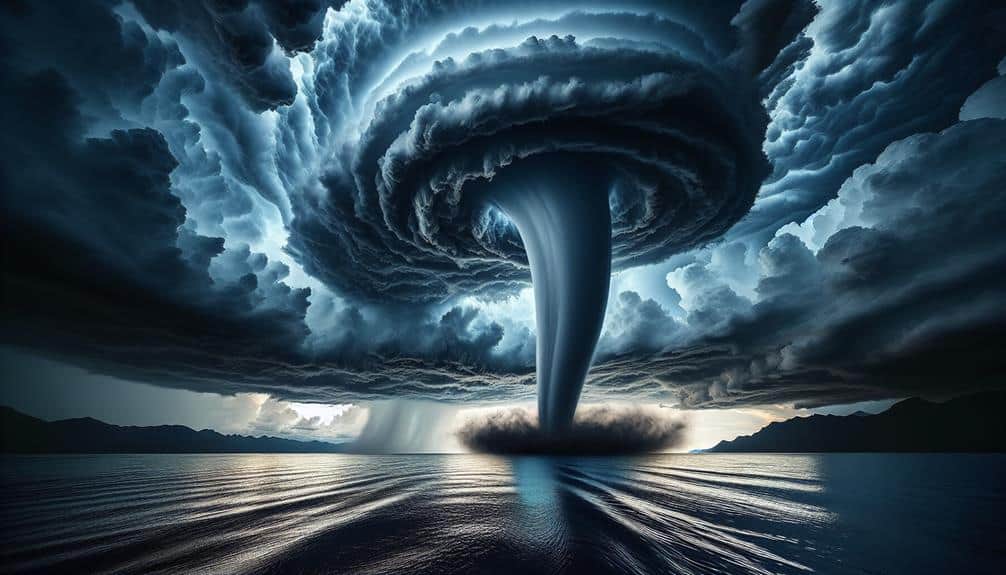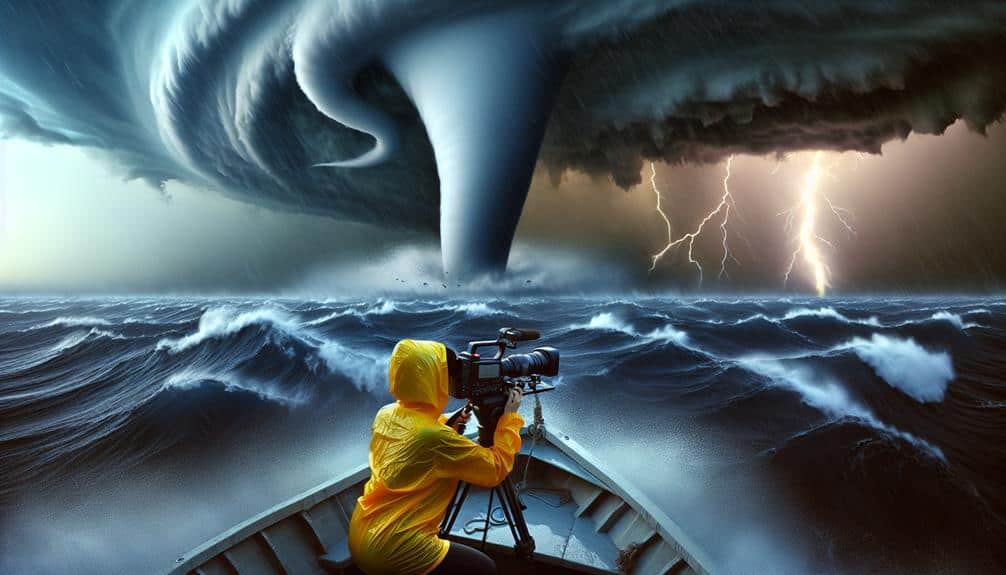We find waterspouts utterly mesmerizing due to their unique formation process involving dramatic temperature differentials and wind shear over water bodies. These columns of rotating air provide an intriguing display of nature's power and complexity, particularly as they emerge from cumulus clouds. Analyzing their life cycle—formation, maturity, and decay—offers an accessible yet dynamic introduction to meteorology. Moreover, the predictability based on weather patterns encourages curiosity and hands-on learning. As we dive deeper into their formation, recommended gear, and ideal observation spots, we'll gain a thorough understanding, making the phenomenon even more compelling.
Key Points
- Waterspouts offer a dramatic and visually stunning display of nature's power.
- Observing waterspouts combines excitement and learning about meteorological phenomena.
- The dynamic motion and formation stages of waterspouts captivate beginners.
- Photographing waterspouts provides a unique and rewarding challenge for enthusiasts.
Understanding Waterspouts
Let's explore the science behind waterspouts, which are fundamentally intense columns of rotating air over bodies of water. These meteorological phenomena, akin to tornadoes, form when specific atmospheric conditions converge. Typically, waterspouts emerge from cumulus clouds, where warm, moist air rises and meets cooler air aloft. This temperature differential, combined with wind shear, initiates the formation of a water vortex.
First, let's consider the data: waterspouts are categorized into two types—fair-weather and tornadic. Fair-weather waterspouts, common in subtropical regions, usually arise in calm conditions and are less destructive. Tornadic waterspouts, however, are associated with severe thunderstorms and can reach wind speeds exceeding 100 mph. Understanding the distinction is vital for both safety and scientific analysis.
We should also note the life cycle of a waterspout. It generally consists of five stages: formation, early development, mature stage, decay, and dissipation. During the mature stage, the vortex is fully visible, often drawing water high into the air, creating a mesmerizing yet potentially dangerous spectacle.
Essential Gear
Given the complexity and unpredictability of waterspouts, equipping ourselves with the right gear is essential for both observation and safety. Proper gear selection is vital; beginners often make mistakes by either underestimating the required equipment or selecting inappropriate tools.
Binoculars with image stabilization and telephoto lenses are necessary for capturing detailed observations. Additionally, a reliable anemometer will help us measure wind speeds accurately, a significant variable when studying waterspouts.
For recording data, a waterproof notebook and pen guarantee our notes remain intact even in adverse conditions. A GPS device aids in tracking our location precisely, which is particularly important when comparing field data with meteorological reports. We must emphasize equipment maintenance; regularly calibrating our anemometers and cleaning our optics prevent data inaccuracies and prolong gear lifespan.
Safety tips include always packing extra batteries and ensuring all electronic devices are charged. A sturdy, waterproof bag protects our equipment from sudden weather changes. By adhering to these guidelines, we avoid common beginner mistakes and maximize our observational efficiency.
In our quest for freedom and discovery, being well-prepared with the right gear not only enhances our experience but also guarantees we conduct our studies safely and effectively.
Safety Precautions
In the domain of waterspout observation, following strict safety measures is essential to guarantee both our personal safety and the integrity of our research. Waterspouts, while awe-inspiring, present significant hazards if we don't take appropriate precautions. According to the National Weather Service, waterspouts can produce winds exceeding 50 knots, posing risks to both vessels and individuals.
First, we must always monitor real-time weather data from reliable sources. This allows us to anticipate waterspout formation and avoid hazardous areas.
Next, adhering to emergency protocols is critical. This includes having life jackets, emergency flares, and first aid kits readily accessible. Our vessels should be equipped with communication devices, such as VHF radios, to maintain contact with the Coast Guard in case of an emergency.
We also need to establish a clear evacuation plan, ensuring everyone knows the procedure if a waterspout approaches. Additionally, understanding the lifecycle and behavior of waterspouts can help us make informed decisions. By studying their formation, movement, and dissipation, we can better predict their paths and avoid dangerous encounters.
Let's respect these natural phenomena and prioritize our safety while embracing the freedom of exploration.
Best Locations
Let's analyze the best locations for observing waterspouts, focusing on coastal hotspots with high occurrence rates.
We'll examine popular sightseeing destinations known for these phenomena and identify the top seasonal viewing opportunities based on meteorological data.
Coastal Hotspots for Waterspouts
Many coastal regions, particularly those in tropical and subtropical zones, offer prime conditions for waterspouts to form, making them ideal hotspots for observation and study. The Florida Keys, for instance, are renowned for these unique formations due to the confluence of warm ocean waters and favorable atmospheric conditions. Scientific explanations show that waterspouts typically form when cold air moves over warmer waters, creating a vertical temperature gradient that fuels the vortex.
In the Mediterranean, the Balearic Islands stand out as another key location. The interaction between sea surface temperatures and localized wind patterns here leads to frequent waterspout events. For those of us excited to capture the mesmerizing beauty of waterspouts, these regions offer both scientific intrigue and stunning scenic views.
When photographing waterspouts, timing and vantage point are essential. Early morning or late afternoon light enhances the visibility and contrast of the vortex against the water. A tripod and a high-resolution camera can help capture the dynamic motion of these ephemeral phenomena.
Popular Sightseeing Destinations
Our exploration of popular sightseeing destinations reveals several locations where waterspouts frequently occur, offering both scientific value and mesmerizing visual experiences.
The Florida Keys stand out as a prime area due to their high frequency of waterspout events. The combination of warm ocean waters and atmospheric conditions makes this an ideal spot, perfect for beach excursions and family vacations.
Another notable location is the Great Lakes region, particularly Lake Erie. Here, the convergence of cooler air masses with the relatively warmer lake surface creates excellent conditions for waterspout formation. For those interested in marine wildlife, this area also offers fantastic opportunities to observe aquatic ecosystems while awaiting waterspout activity.
In the Mediterranean, the coastal zones of Italy and Greece are hotspots. These regions not only provide picturesque settings but also present great chances for waterspout sightings. For photography enthusiasts, clear skies and abundant light offer ideal conditions for capturing these phenomena.
We recommend using a telephoto lens and a fast shutter speed to capture the dynamic nature of waterspouts.
Seasonal Viewing Opportunities
Understanding the best seasonal opportunities for viewing waterspouts is important, as specific times of the year greatly enhance the likelihood of witnessing these fascinating phenomena. Waterspouts are most commonly observed during late spring to early fall, particularly in regions with warm sea surface temperatures and atmospheric instability. This period aligns with the peak of the waterspout season in both the Northern and Southern Hemispheres.
In the Northern Hemisphere, areas like the Florida Keys and the Great Lakes are prime locations during the summer months. The warm waters and frequent thunderstorms create ideal conditions for the formation of these stormy fascinations. In contrast, the Mediterranean Sea offers excellent viewing opportunities in the fall, particularly from September to November.
The Southern Hemisphere also provides unique viewing opportunities, especially along the coasts of Australia and New Zealand. Here, waterspouts are most frequently observed during their summer months, from December to February. Coastal regions with warm waters and convective weather patterns are hotspots for these unique phenomena.
Weather Patterns

Analyzing weather patterns reveals that waterspouts frequently form under specific atmospheric conditions, such as the presence of cumulus clouds and converging wind currents. These phenomena often intrigue us, especially when we consider their connection to storm chasing and other atmospheric phenomena. By examining data from climate science, we can identify the meteorological wonders that lead to their formation.
Waterspouts typically develop in regions where warm, moist air rises and interacts with cooler air above. This interaction creates instability, leading to the formation of cumulus clouds. When converging wind currents at the surface and aloft align, they generate a rotating column of air. This rotation, combined with the vertical development of clouds, enhances the likelihood of waterspout formation.
Our fascination with waterspouts also stems from their predictability within certain weather patterns. By studying historical weather data and utilizing modern meteorological tools, we can anticipate the conditions favorable for waterspout development. This predictability fuels our desire for freedom in storm chasing, allowing us to witness these atmospheric phenomena firsthand.
Ultimately, understanding the complex interplay of weather patterns not only deepens our appreciation for waterspouts but also highlights the broader implications of climate science in predicting and responding to meteorological wonders.
Capturing the Moment
With the right equipment and knowledge, we can capture stunning images and data of waterspouts, providing valuable insights into their dynamics and behavior.
When storm chasing, the adrenaline rush of witnessing nature's beauty firsthand is unparalleled.
To maximize our photographic endeavors, we must follow specific photography tips that enhance both safety and the quality of our captures.
- Use a telephoto lens: This allows us to maintain a safe distance while still obtaining detailed images of the waterspout.
- Stabilize our camera: A tripod or a steady hand is vital for reducing motion blur in high-wind conditions.
- Monitor weather radar: Real-time data helps us predict the formation and movement of waterspouts, optimizing our positioning.
- Adjust shutter speed: Faster shutter speeds can freeze the motion of a rapidly rotating waterspout, providing clearer images.
Frequently Asked Questions
Can Waterspouts Form in Freshwater Lakes or Rivers?
Freshwater formations, like lakes and rivers, can indeed host waterspouts. Weather patterns play a key role. Unlike ocean waterspouts, lake waterspouts exhibit unique characteristics shaped by localized conditions, offering a distinct, mesmerizing spectacle of nature's power and beauty.
How Long Do Waterspouts Typically Last?
We find waterspouts' duration generally ranges from 5 to 30 minutes. Their formation process involves intense, localized atmospheric conditions, making their short-lived nature a tribute to the dynamic freedom of natural phenomena.
Are There Different Types of Waterspouts?
Coincidentally, just as we learned about their duration, we now discover that there are indeed different types of waterspouts. These formations depend on specific weather conditions, including tornadic waterspouts and fair-weather waterspouts, each with unique characteristics.
What Is the Largest Waterspout Ever Recorded?
We're always driven by extreme weather and curiosity. The largest waterspout ever recorded measured approximately 2 miles in diameter. Such record-breaking phenomena are awe-inspiring, showcasing the incredible power and unpredictability of nature.
Can Waterspouts Move Onto Land and Become Tornadoes?
Coincidentally, waterspouts can undergo land transformation and become tornadoes. Observational data show freshwater occurrences, like river formation, rarely produce such events. Analyzing tornado connection in these transformations reveals variable dynamics influenced by environmental conditions.


